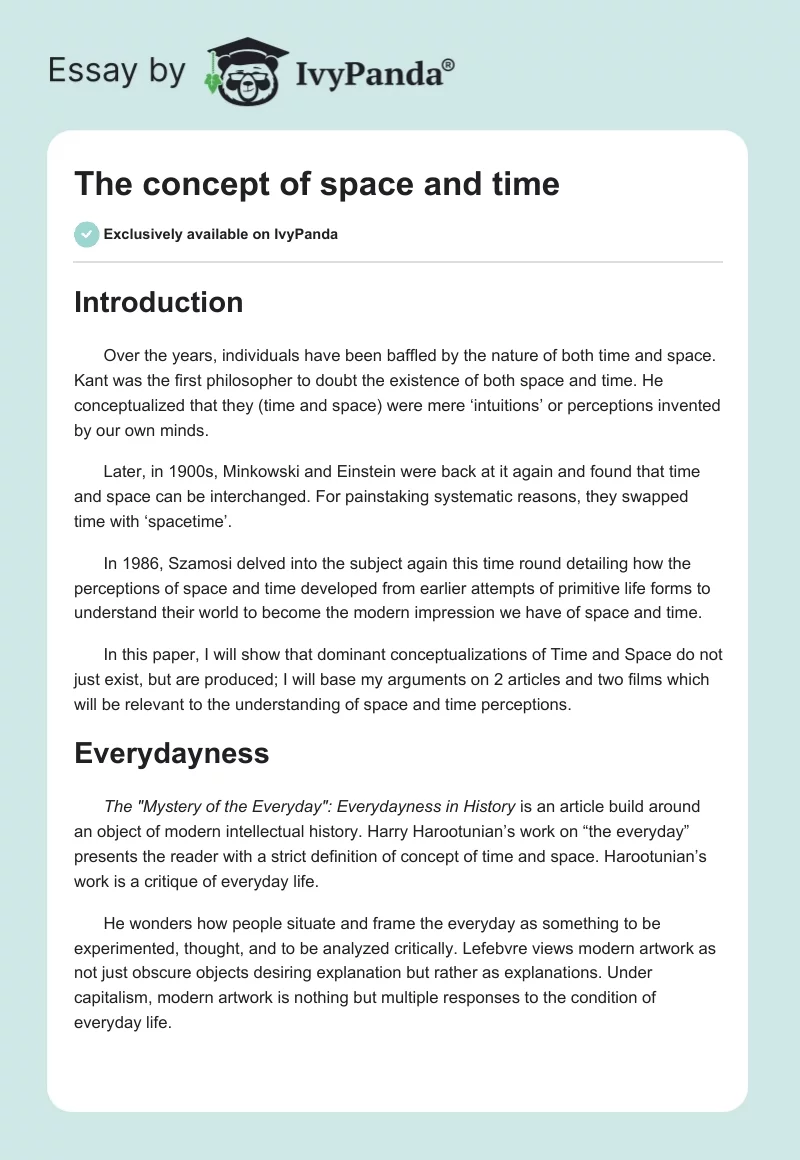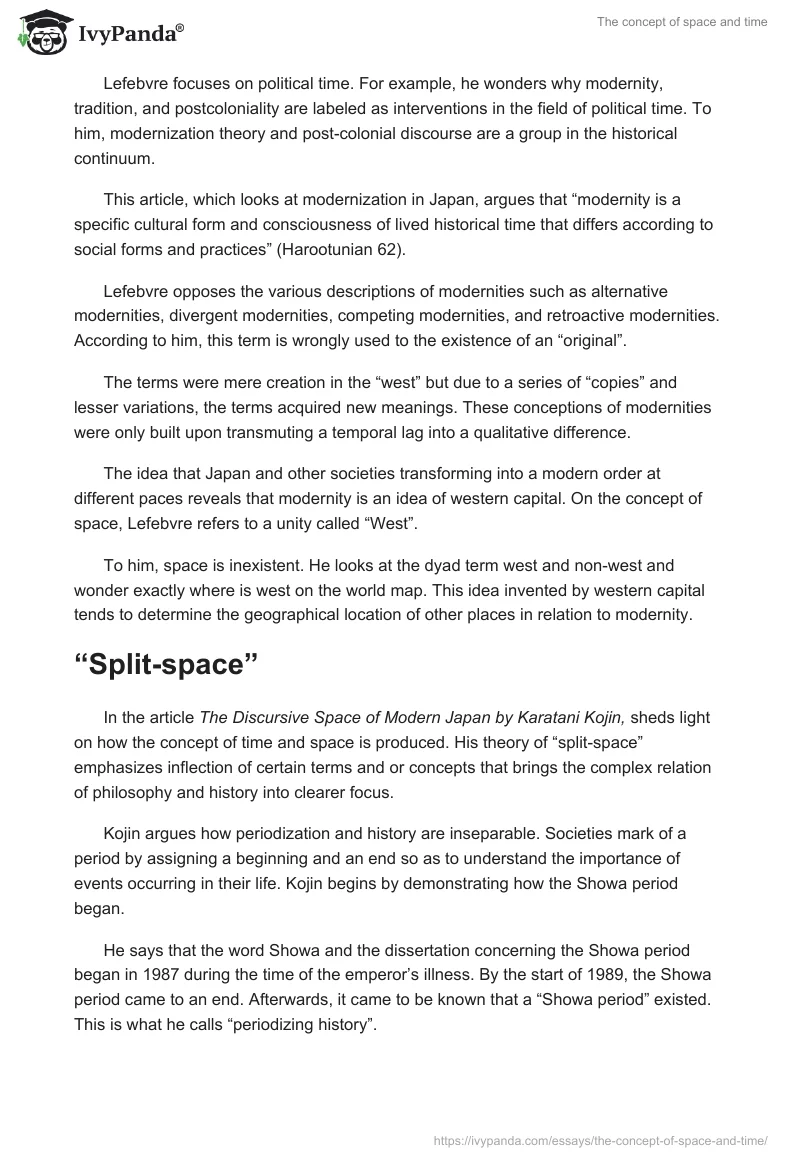Introduction
Over the years, individuals have been baffled by the nature of both time and space. Kant was the first philosopher to doubt the existence of both space and time. He conceptualized that they (time and space) were mere ‘intuitions’ or perceptions invented by our own minds.
Later, in 1900s, Minkowski and Einstein were back at it again and found that time and space can be interchanged. For painstaking systematic reasons, they swapped time with ‘spacetime’.
In 1986, Szamosi delved into the subject again this time round detailing how the perceptions of space and time developed from earlier attempts of primitive life forms to understand their world to become the modern impression we have of space and time.
In this paper, I will show that dominant conceptualizations of Time and Space do not just exist, but are produced; I will base my arguments on 2 articles and two films which will be relevant to the understanding of space and time perceptions.
Everydayness
The “Mystery of the Everyday”: Everydayness in History is an article build around an object of modern intellectual history. Harry Harootunian’s work on “the everyday” presents the reader with a strict definition of concept of time and space. Harootunian’s work is a critique of everyday life.
He wonders how people situate and frame the everyday as something to be experimented, thought, and to be analyzed critically. Lefebvre views modern artwork as not just obscure objects desiring explanation but rather as explanations. Under capitalism, modern artwork is nothing but multiple responses to the condition of everyday life.
Lefebvre focuses on political time. For example, he wonders why modernity, tradition, and postcoloniality are labeled as interventions in the field of political time. To him, modernization theory and post-colonial discourse are a group in the historical continuum.
This article, which looks at modernization in Japan, argues that “modernity is a specific cultural form and consciousness of lived historical time that differs according to social forms and practices” (Harootunian 62).
Lefebvre opposes the various descriptions of modernities such as alternative modernities, divergent modernities, competing modernities, and retroactive modernities. According to him, this term is wrongly used to the existence of an “original”.
The terms were mere creation in the “west” but due to a series of “copies” and lesser variations, the terms acquired new meanings. These conceptions of modernities were only built upon transmuting a temporal lag into a qualitative difference.
The idea that Japan and other societies transforming into a modern order at different paces reveals that modernity is an idea of western capital. On the concept of space, Lefebvre refers to a unity called “West”.
To him, space is inexistent. He looks at the dyad term west and non-west and wonder exactly where is west on the world map. This idea invented by western capital tends to determine the geographical location of other places in relation to modernity.
“Split-space”
In the article The Discursive Space of Modern Japan by Karatani Kojin, sheds light on how the concept of time and space is produced. His theory of “split-space” emphasizes inflection of certain terms and or concepts that brings the complex relation of philosophy and history into clearer focus.
Kojin argues how periodization and history are inseparable. Societies mark of a period by assigning a beginning and an end so as to understand the importance of events occurring in their life. Kojin begins by demonstrating how the Showa period began.
He says that the word Showa and the dissertation concerning the Showa period began in 1987 during the time of the emperor’s illness. By the start of 1989, the Showa period came to an end. Afterwards, it came to be known that a “Showa period” existed. This is what he calls “periodizing history”.
Karatani in particular criticizes Japan for neglecting the possibilities present during its inception that were instead replaced by modernist ideology and the nation state system. According to Kojin, comparative history is not fit for measuring Japanese historical trajectory against another build upon European-based model of development.
Such a move, he advises, is likely to yield problems as it may endanger productive discussions. The Japanese ‘feudalism’, connected to Tokugawa political system, put Japanese history in a relative framework and pitted Japanese historians with those from medieval Europe.
Such a formulation suggests a comparison without connection; labeling Tokugawa Japan “feudal” imply placing Japanese development with events happening in Europe and in a different era. Terms like “Early Modern Japan” means an entirely different thing.
Karatani points to the Christian calendar and Japanese periodization saying that “both serve to make explicit the fact that each nation’s ‘era/world’ is only a communal, illusory space, and that a plurality of worlds (eras/worlds) exists simultaneously, maintaining relations with one another” (Kojin 77).
To Kojin, history relies on the marking of a period so as to understand the importance of events and occurrences. History is all about the question of periodizing and periodization has the tendency of altering the importance of events!
Kojin’s split-pace theory of reception as it appears tends to suggest that in the future, his own theory will be split and decentered. To kojin, centers and margins are a play of transposition. We cannot entirely argue that margins and centers do not exist.
The center is somehow blind and the peripheral or the margins do not necessarily need to cope with. Kojin fail to understand that the west has been marginal itself. Karatani focuses his theory towards the west rather than being post-colonial. It tends to get lost in concepts of time and space it is supposed to analyze.
Three Times
Hou Hsiao-hsien’sThree Times is the only of his many movies that delves into historical material. This is a triptych of stories of love that are narrated in different time periods but stared by the same actors.
In this movie, Hou Hsiao-hsien combines the past and the present in a way that he creates free floating narratives that are not tied to any chronological progression.
Hou Hsiao-hsien puts a lot of effort in the development of these semi-related tales and at no one time in the movie does he succumb to straightforward duplication. The film is entangled with its director’s conviction in the powerful influence of history on here and now (Three Times 2007).
The ‘Three times’ has a 1966 introductory segment titled “A time for love”. The plot however shifts backwards in time and tell of an actor named May’s maiden arrival at the pool-hall.
This is a way for Hou Hsiao-hsien to make his audience to revisit and reassess through their memory what led to the current situation. It is worth noting that this is only a primer to the following stories that are full of historical shading.
Part two of the movie-“A time for freedom” is yet another rumination of historical episode. The scene is set in 1911 in Taiwan reflecting the difficulties, and unbalanced realities facing mankind during the start of the century. Qi’s performance in this part reflects Taiwan as she struggled to free herself from imperial Japan rule.
The final episode – “A time for Youth” is a depiction of modern day Taipei youth mixed in the millennium Mambo’s pop music and juvenile aimlessness. When Hou Hsiao-hsien displays a suicide note on the monitor although having said so in narration, he makes his audience revisit the past again. This is a plea to the Taiwanese to embrace their history.
Hou Hsiao-hsien is a puppetmaster. “A time for Love” happens when Hou Hsiao-hsien was about the same age as two of the lovers. This could only be taken to mean that his age may not be the same to that of the youth of the present. However, he is looks more at ease in the future than in the past. With Hou Hsiao-hsien, time and space do not exist – they are notions created in the peoples’ mind.
Sabu’s Monday
In Sabu’s ‘Monday (2000), the scene is a hotel room and a man, Takagi, wakes up not knowing how he got there in the first place. Takagi reaches over the table and pick a newspaper, checks the front page and realizes that it’s Monday. The last day he can remember is Saturday.
Takagi has no recollection of what occurred between Saturday and Monday! Sabu leaves the audience to work out the puzzle with him as he leads them through Takagi’s scrappy memory of his missing 48 hours. When a packet of sanitizing salt falls from his pocket, he starts recollecting what occurred.
We are taken back to a funeral scene, a graveside; the conversation turns out to be a shoot-out after Takagi disagrees with his girlfriend. The audience then shifts from the unsteady weekend of Takagi to the hotel scene. This makes flashback gain relevance. Outside the hotel, Takagi learns from a hotel TV that he is surrounded by police (Monday 2000).
From the story, we learn that after the quarrel following the burial, Takagi got angry and armed with a gun from a Yakuza club, he embarks on a vigilante killing orgy. Takagi not only killed the boss of the yakuza gang but also some street punks in the process. Takagi shifts from being sober and at times he becomes murderous.
The goal of Sabu’s movie is to show how the world is capable of drawing out the dark side that each of us possess. The movie lacks the aspect of time. To Sabu, we are capable of traveling anywhere in the notion of time.
Conclusion
The four works have demonstrated how time and space are creations of the mind that help mankind understand the world. In the Mystery of everyday: Everydayness in history, Harootunian clearly demonstrates how the west created the term modernity and industrialization in the process of marking Japan and other slowly developing countries as lagging back in time.
He criticizes labeling japan underdeveloped in the sense of time because of its peripheral location on the world map. Karatani Kojin in The Discursive Space of Modern Japan argues that periodization – creation of time – is inherent in history, to mark the beginning and the end of a certain period of interest.
In Three times, directorHou Hsiao-hsien tells a story devoid of both space and time. His film is set in three different times and places.
Hou is capable of making his audiences traverse between different times with ease. He is not in any way restricted by timing in the setting of his movies as both are notions to him. Sabu’s Monday, is similar to Hou Hsiao-hsien’s ‘Three times’. Sabu makes his audience traverse between the past and the present in the process erasing the notion of both time and space.
Works Cited
Harootunian, Harry. History’s Disquiet: Modernity, Cultural Practice, and The Question Of Everyday Life. Columbia: Columbia University Press, 2000. Print.
Karatani, Kojin. The Discursive Space of Modern Japan. London: Duke University Press, 1991. Print.
Monday. Dir. Hiroyuki Tanaka.Perf.Shin’ichiTsutsumi, Yasuko Matsuyuki, Hijiri Kojima. download, 2000. DVD.
Three Times.Dir. Hsiao-hsienHou.Perf. Qi Shu, Chen Chang, Fang Mei. Ifc, 2007. DVD.


